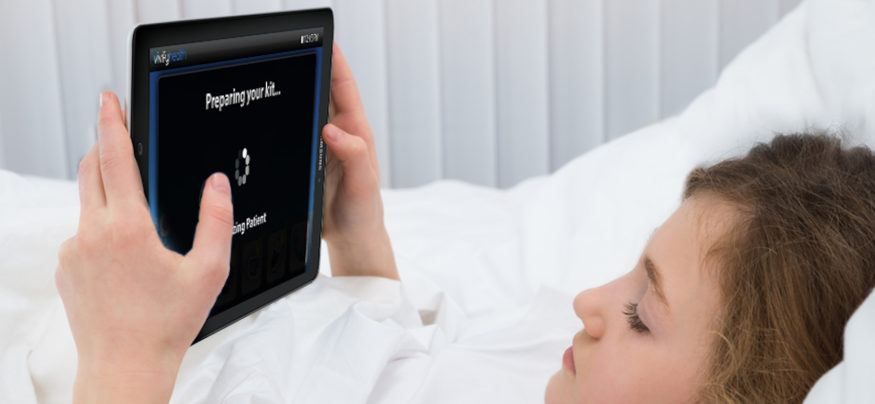The patient experience in healthcare is going digital — and so are hospital rooms. From using digital signage and smart TVs to better engage and educate patients, to retrieving lab results via the electronic health record (EHR), to discharging patients with technology “kits” that include tablets and remote monitoring devices, hospitals are using technology to create a connected healthcare system in what we call “smart patient rooms.” Advancements in display, mobile and wearable technology, integrated with the smart patient room, now make it possible for doctors and medical practitioners to spend less time on administration and more doing what they do best — taking care of patients.
Enabling a Better Inpatient Experience
Using technology to make care more streamlined and efficient is what we’re all about, and patients agree.
With much of the focus in recent years on implementing the EHR, we’ve seen improvements in quality of care and have established technology platforms for streamlining operations to enhance the patient experience. However, one area that hasn’t yet benefited from the EHR is the patient-doctor relationship. In some cases, physicians can be more focused on the computer screen and documenting details of the patient visit than on observing body language and subtle clues to the patient’s condition. This has the potential to negatively impact patient satisfaction, which directly ties into providers’ scores in the Hospital Consumer Assessment of Healthcare Providers and Systems (HCAHPS) survey, and affects reimbursements. Additionally, with more attention on the computer screen and less on the patient-doctor relationship, there’s also significant risk that patient outcomes could suffer.
Create a VR Healthcare Pain Management Program
Explore the key drivers of using VR for pain management and get tips for implementation. Download Now
Some hospitals are taking notice and have begun to implement technology solutions that leverage mobile and display technologies to improve patient engagement. One leading academic medical center uses screen-mirroring technology to transfer images from a tablet to a wall-mounted display during radiology consultations. As the physician reviews and discusses the diagnosis and treatment plan with the patient and their family, the physician is able to screen-mirror the images and relevant information from the tablet to the wall-mounted, large-format display in the consultation room. The patient, their family members and the physician can then view images on the larger high-definition display, which fosters a better understanding of the condition and proposed procedure. Moreover, annotations can be made, saved and later shared with the patient.
Another example of innovation is at New York Presbyterian Hospital, where e-boards are being placed in each patient room. These large displays help to keep patients informed on key information, including who is on their healthcare team (along with pictures and contact information) and their daily schedule of tests and procedures. “I like seeing who my doctor is on the screen and knowing what’s going on for the day,” explains one New York Presbyterian patient.
Mobile Devices Streamline Communications
Smart patient rooms can also capture and transmit data from medical monitoring devices to smartphones carried by nurses, providers and other healthcare staff. Historically, nurses relied on pagers, legacy phones and nurse call lights to receive physiologic alerts and requests from patients. Today, nurses can receive this information in the form of alert notifications directly on the smartphones in their pockets, and can use those same devices to communicate quickly with other members of the care team. One healthcare communication company, Voalte, puts smartphones in the hands of caregivers at the bedside, allowing them to communicate with anyone at any time, no matter where they are.
“By integrating with a hospital’s existing technologies and designing intuitive communication solutions based on the phones people carry every day, we help caregivers focus more on delivering care and less on the technology,” says Adam McMullin, Voalte chairman and CEO. “Voalte helps enhance patient safety, enable high-quality patient outcomes and improve caregiver productivity by delivering information directly to the appropriate caregiver’s smartphone.”
The Power of Patient Engagement
The key to a successful smart patient room is creating an intuitive user experience for both patients and healthcare providers through devices, displays and apps. Baptist Memorial Health Care’s EHR platform, Baptist OneCare, is an excellent example of how in-room technology helps patients engage in their healing and stay out of the hospital longer. Like New York Presbyterian, Baptist Memorial’s smart patient rooms consist of large touchscreen monitors displaying patient vitals and medical team information. Patients also receive 10-inch tablets for viewing their medical records, test results and treatment schedules; communicating with their care providers; and receiving disease management education. Using these tablets or their own devices, patients can access the Epic MyChart portal app to schedule appointments, request refills and contact their care team. Approved family members can also download and use Epic MyChart to see what’s happening with their loved ones.
The ability to access personal medical information can help the healing process, according to Chris Attendorf, director of Baptist OneCare Inpatient Nursing/Clinical Areas at Baptist-Memphis. “Anytime you have patient and/or family engagement, the patient will do much better,” she explains. “They know what’s going on and what to expect. They know what questions to ask and what to look for, and typically that results in better care. It keeps them out of the hospital for longer periods of time. This is really what healthcare is all about at this point — better management of patients through the clinic and hospital, and getting them back to the home environment.”
Smarter Hospital TVs
On average, patients have their TVs on between 11 and 13 hours while they are in the hospital. Healthcare TVs have the potential to enhance the in-room entertainment experience by integrating EHR information to serve up relevant content related to procedures and recovery. The technology also tracks patients’ engagement rates so they can be prompted to view more information as needed.
Through deployments of Samsung healthcare TVs with TeleHealth Services, Kaiser Permanente Panorama City Hospital in Southern California has observed an 8 percent increase in the number of patients who “understand their condition” and a 12 percent increase in hospital satisfaction ratings by patients. Moreover, Kaiser Panorama City experienced a 12 percent reduction in pneumonia and cardiac readmissions after the implementation of the TeleHealth Services patient education solution on smart TVs. Across the country in New York City’s Elmhurst Hospital Center, patient education through video has increased by 93 percent, and patient satisfaction levels have increased by double digits year over year.
Another important element of the patient education engagement strategy is the deployment of bedside tablets that directly link to patient education materials. Using the Sonifi Health interactive patient education solution, patients at Texas Health Resources in Dallas, Texas are able to view patient education materials on their healthcare TVs and answer corresponding questions on bedside tablets. Hospital clinical staff can then track whether patients have completed specific learning modules and/or require additional education and support on certain topics.
Continuing Care Outside the Hospital
Some hospitals are closing the care loop by extending the smart patient room experience to patients’ homes. At Children’s Health in Dallas, pediatric transplant patients and care providers collaborate on a post-discharge care program that combines Vivify Health’s platform with Samsung Galaxy tablets. Patients use the tablets and Bluetooth-enabled devices to record their blood pressure, weight and other biometric data daily, and care providers access this information to follow up with patients via videoconferencing or house calls. All the data is integrated with the patient’s EHR so providers can access all historic and real-time information in one place.
This program has been extremely well received. Vivify Health reports that 100 percent of medical staff and 95 percent of patients are satisfied with the program, and length of stay has decreased. Patients who might normally have to come in twice weekly for follow-up appointments can now receive the same care through a videoconference call.
These are just a few examples of how connected technologies are driving healthcare efficiencies inside and outside of hospitals. In the HIMSS 2016 Connected Health Survey, 47 percent of surveyed IT and clinical professionals reported that they expect to expand their use of connected health technologies over the next few years. The survey also reveals that hospitals are using an array of connected health technologies, from SMS to mobile-optimized patient portals similar to those in use at Children’s Health and Baptist Memorial. The exponential amount of data that each of these technologies generates underscores the need for a common communications platform to facilitate this growth and more broadly, the industry’s goal of achieving value-based care. With technology providers, patients and medical staff working together to create a connected healthcare system, a future with more efficient, cost-effective care comes into sharper focus.
Interested in learning more about how technology can create a more connected patient experience? Read about how the traditional waiting room is becoming a patient engagement hub.









